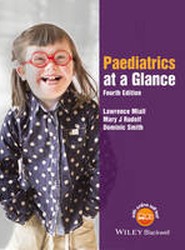(To see other currencies, click on price)
MORE ABOUT THIS BOOK
Main description:
Children and Young People s Nursing at a Glance, is the perfect companion for study and revision for pre-registration children s nursing students from the publishers of the market-leading at a Glance series. Divided into seven sections it explores assessment and screening, working with families, the newborn infant, the developing child, child health policy, nursing the sick child and young person and chronic and life-limiting conditions. This comprehensive book is an invaluable resource for pre-registration nursing students as well as newly qualified nurses wanting to consolidate and expand their knowledge of children and young people s nursing.
* Breaks down complex aspects of child health care in an accessible and un-intimidating way * The perfect revision and consolidation textbook * Linked closely with the NMC standards for pre-registration nursing education, and the essential skills clusters framework * Highly visual colour presentation, with approximately 130 illustrations * Includes boxes, summary boxes, key points and recommendations for practice to improve the learning experience * Supported by a companion website featuring over 500 interactive multiple choice questions (www.ataglanceseries.com/nursing/children) * Available in a range of digital formats - perfect for 'on the go' study and revision
Contents:
Preface viii Contributors ix How to use your revision guide xiv About the companion website xvii Part 1 Assessment and screening 1 1 Assessment of the child 2 2 SBAR framework 4 3 The nursing process 6 4 Nursing models 8 5 The care plan 10 6 Record keeping 12 7 Engagement and participation of children and young people 14 8 Observation of the well child 16 9 Observation of the sick child 17 10 Septic screening 19 11 Advanced physical assessment 20 12 Developmental assessment 22 13 Paediatric Early Warning Score 24 14 Paediatric critical care 26 15 Understanding investigations 28 16 Understanding blood gas analysis 30 17 Understanding blood chemistry 32 18 Understanding pathology specimen collection 34 19 Understanding X-rays 36 20 Pulse oximetry 38 21 Central venous devices 40 22 Tracheostomy care 42 23 Infant resuscitation 44 24 Young person resuscitation 46 25 Resuscitation drugs 48 26 Emergency care 50 Part 2 Working with families 53 27 Partnership 54 28 Family centred care 56 29 Family health promotion 58 30 Communicating with children 60 31 Hospital play 62 32 Role of the community children s nurse 64 33 Collaboration with schools 66 34 Family information leafl ets 68 35 Safeguarding 70 36 Fabricated or induced illness 72 37 Gaining consent or assent 73 38 Clinical holding 74 39 Breaking bad or signifi cant news 76 40 Care of the dying child 78 41 Dealing with aggression 80 42 Minimizing the effects of hospitalization 82 43 Transition 84 Part 3 The newborn infant 87 44 Fetal development 88 45 Neonatal examination 90 46 Neonatal screening tests 92 47 The premature baby 94 48 Neonatal transport 96 49 Jaundice and hyperbilirubinaemia 98 50 Congenital heart disease 100 51 Neonatal resuscitation 102 52 Incubator/Babytherm care 104 53 Sudden infant death syndrome 106 Part 4 The developing child 109 54 Nutrition in childhood 110 55 Breastfeeding 112 56 Bottle feeding 114 57 Feed calculations 116 58 Percentile charts 118 59 Child development: 0 5 years 120 60 Child development: 5 16 years 122 61 Age-appropriate behaviours 124 62 Common behavioural problems of childhood 126 63 Adolescent development 128 64 Child health promotion 130 65 Immunity and immunization 132 66 Childhood immunizations 134 Part 5 Child heath policy 137 67 Child health policy 138 68 The rights of children in hospital 140 69 The NHS Change Model 142 70 Young person policy 144 71 Child disability policy 146 Part 6 Nursing the sick child and young person 149 72 Pain assessment 150 73 Pain management 152 74 Preoperative preparation 154 75 Postoperative care 156 76 Pressure area care 158 77 Managing fluid balance 160 78 Administering medication 162 79 Drug calculations 164 80 Enteral and nasogastric feeding 166 81 The feverish child 168 82 Infectious childhood diseases 170 83 Assessing infectious diseases 172 84 Prevention of infection 174 85 Hyponatraemia and its prevention 176 86 Thermal injuries 178 87 Childhood fractures 180 88 Plaster care 182 89 Traction care 184 90 Neurovascular observations 186 91 Neurological problems 188 92 Brain injury and coma 190 93 Seizures 192 94 Meningitis 194 95 Septicaemia 196 96 Respiratory problems 198 97 Asthma 200 98 CPAP and BiPAP 202 99 Cardiovascular assessment and shock 204 100 Inflammatory bowel disease 206 101 Gastro-oesophageal reflux 208 102 Coeliac disease 210 103 Appendicitis 212 104 Constipation 214 105 Renal problems 216 106 Haematological problems 218 107 Musculoskeletal problems 220 108 Reproductive and sexual problems 222 109 Skin conditions 224 110 Atopic eczema 226 Part 7 Chronic and life-limiting conditions 229 111 Living with chronic illness 230 112 Cystic fi brosis management 232 113 Juvenile idiopathic arthritis 234 114 Epilepsy 236 115 Childhood cancer 238 116 Cleft lip and palate 240 117 Diabetes 242 118 Diabetes management 244 119 Childhood obesity 246 120 Eating disorders 248 121 Mental health problems 250 122 Self-harm in childhood 252 123 What is a learning disability? 254 124 Autistic spectrum disorder 256 125 Communicating with the child who has a learning disability 258 126 Positive behavioural support 260 127 Atrioventricular septal defect in children with learning disability 262 128 Genetic conditions: Down s syndrome 264 129 Other genetic conditions 266 References and Further reading 268 Index 275
PRODUCT DETAILS
Publisher: John Wiley & Sons Ltd (John Wiley & Sons Inc)
Publication date: November, 2014
Pages: 288
Dimensions: 216.00 x 272.00 x 16.00
Weight: 814g
Availability: Available
Subcategories: Diseases and Disorders, Nursing
Publisher recommends
From the same series


























































